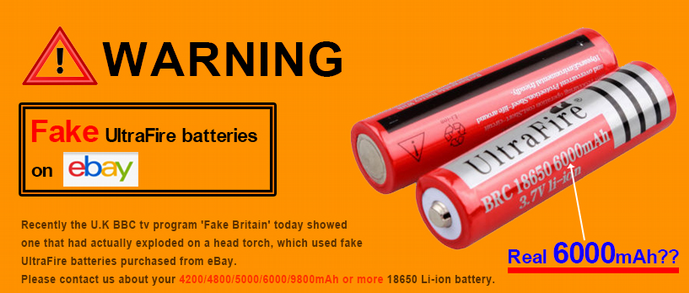
How to tell if 18650 batteries are real or fake
18650 batteries are a very popular type of small cylindrical lithium-ion batteries. These batteries usually have a nominal voltage of 3.6-3.8 volts, a maximum voltage of 4.25 volts, can be over three amp-hour and are 18 millimeters in diameter and 65.0 millimeters long, hence the name 18650.
These batteries are used in packs in many places, ranging from laptops, to cordless power tools, to pocket-size vehicle jump starters, to portable power banks. They are also used by themselves, in items like flashlights and headlamps, vaporizers (e-cigarettes), or cordless screwdrivers.
These batteries are often very powerful for their size. Some of these batteries can put out an impressive 20 amps per cell continuously, while maintaining over one amp-hour at more than three volts, not overheat, and still get a good total lifetime. The ones used in jump starters can often momentarily crank out over 150 amps per cell! They are also relatively inexpensive. Clearly, these are a great choice if you are looking for good rechargeable batteries.
The biggest problem with them being so common is that many people are duplicating them with fake batteries. These fakes may range from cheap batteries with misleading or completely lying labels, used batteries that are sold claiming to be “new”, or smaller batteries wrapped in paper that are stuffed inside an 18650 case.
These fake 18650's have become a large problem; aside from the fact that it is illegal and also hurts companies if people duplicate their batteries and pretend they are the company's batteries, these batteries are dangerous. There have been several reports of these batteries overheating or shorting out internally, sometimes to the point of exploding! In fact, at the time this article was written, UltraFire's home page gave a report about one of the fake batteries, that was pretending to be one of UltraFire's own batteries, exploding inside a headlamp. This is what it showed:

UltraFire Home Page
There are a surprising number of fake 18650's available, in fact they are even sold, often by mistake, by honest, reliable, common vendors, such as Amazon and Ebay sellers, your local vape shop down the street, or at regular stores that you wouldn't ever expect to find fakes at.
So with all these fake batteries around, mixed in with the real ones, how do we tell if the ones we look at or already own are fakes???
Luckily, there is a way.
No scammer is perfect. There is always some way to tell if the batteries are fakes. These ways to tell range from outrageous stated capacities, to the weights of the individual cells, to measuring the capacity of the cell, or many other ways.
The most obvious and most important way is the advertised capacities. The most important rule of thumb to remember: THERE ARE CURRENTLY NO 18650 BATTERIES WITH ANY CAPACITY GREATER THAN 4000 MILLIAMPERE HOURS!!! Any battery stating a capacity greater then this is either exaggerating or lying. Another thing to remember is that in almost every case, 18650 batteries will cost more than $5 each. The cheapest I have ever seen were $9.99 for a two pack, and these were on sale (20% off) on Cyber Monday. Be wary of the cheaper ones, such as the 20-packs of “12000mah” batteries for only $19.97.
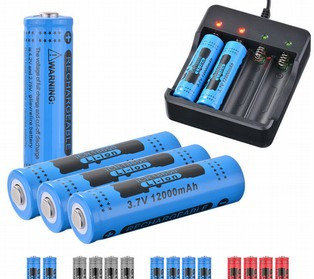
These batteries state a ridiculous 12000 milliamp-hours, so they are guaranteed to be fake.
Also, the used ones sold as new are often easy to tell, as they often have marks on them from use or abuse. Some of these may include:
-Rust spots
-Small burns
-Scratches on the terminals
-Dents in the negative terminal
I got three 18650 batteries to dissemble and determine whether they are fakes or not. The first one is this one shown in the picture:
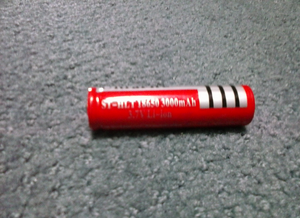
This battery claims to be a 3000 miliamp-hour UltraFire with re/discharge protection. If we look on the UltraFire website, we can see that Ultrafire does indeed sell batteries almost like this. There is a noticeable difference, however. This battery claims to have protection, but at the time that this article was written,Ultrafire only sold batteries of this design with protection:
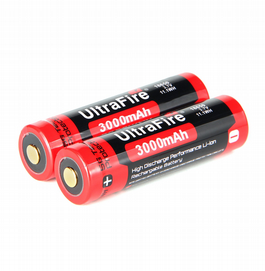
All of the batteries that UltraFire sells that look like the first design do not have recharge or discharge protection. Therefore, we can determine right off that this battery is a fake. Let's look at it more closely.
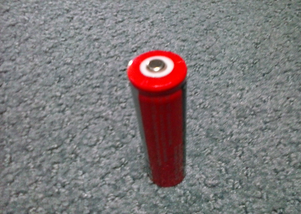
We can see here that it has a button-top design, rather than a flat-top design.

And here, after I take off the PVC wrapper, we can see that it has a slightly raised end on the negative side. This is usually a cover put on to enclose a negative side protection circuit. Except that on this battery, there is no seam between the protection circuit cap and the actual negative terminal, as shown in this picture.

This shows that the bump is part of the actual terminal, to make it look like a protection circuit is there, even though there isn't one.
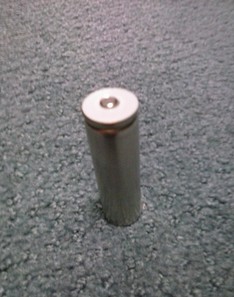
Looking at the positive terminal, we can see a thin white plastic washer. Normally, these washers are less slick and brittle than this one, and they have a red paper washer underneath with adhesive on both sides to keep both washers on and together. What I find interesting about this one is that it just falls off, and there is no other washer underneath it.
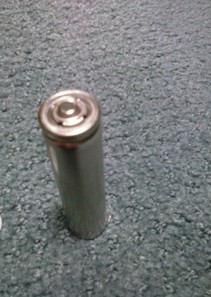
Also, looking at the terminal, normally these batteries have flat-top designs with buttons soldered to the tops of them. This one has no separate button.
The next thing to do is weigh the battery. I use a small postal scale for weighing these, and it turns out that the weight of this battery is only 35 grams. The official weight of these batteries is 50 grams, according to UltraFire. This leads me to believe that there is really not much to these batteries.
The next test to do is the discharge test. This involves taking a multimeter and measuring the current draw (in milliamps) of a small load that takes that battery, such as a flashlight. Then put the battery in the flashlight (make sure the battery is fully charged - 4.1 volts minimum) and turn on the flashlight. Mark down the time that the light was turned on. Then turn it off every once in a while and check the battery voltage. Once the voltage is at 3.0 volts without a load, the battery is considered dead and you can turn off the flashlight.
Check the time it took to drain the battery in hours, then multiply that by the current draw. This will give you the number of milliamp hours that the battery actually holds.
On our battery, I did that test. The headlamp I used conveniently drew 1000 milliamps (easy math there), so it should have lasted about 3 hours. Instead, it lasted 40 minutes, or 0.6 hours. That means that the actual capacity of this battery is only 1000x0.6=600 milliamp hours. Very poor. There really isn't much at all to these batteries.
Let's look at another battery.

According to the label on this battery (LGDAHB31865), it appears to be a flat-top 1500 milliamp-hour battery made by LG. It is certainly within the allowable capacity range, plus LG makes batteries that look identical to this one.
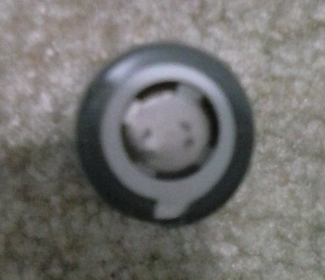
Looking at the positive terminal, it still seems to be a true LG battery. LG uses the style with four connection points.
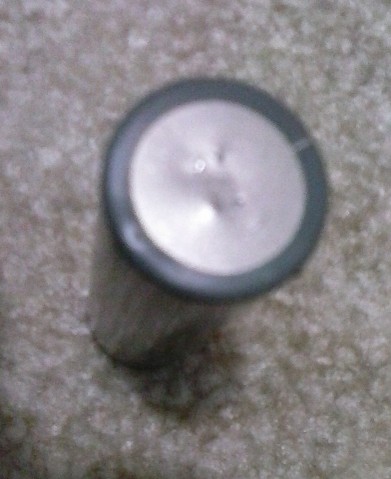
It does not advertise having a protection circuit, and it does not appear to either. So far so good.
The positive terminal washer looks good, is stuck on, and feels real. The battery weight is 45 grams as specified.
And after doing a discharge test that came out to 1500 milliamp-hour, I can determine that this battery is real.
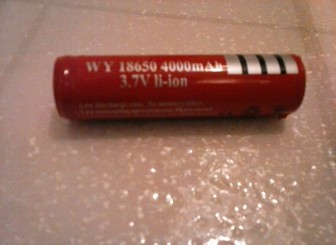
This battery claims to be a 4000 milliamp-hour button-top UltraFire with a protection circuit. On this battery we can determine right off that it is fake, due to the 4000 milli-amp hour rating. Currently, UltraFire does not sell anything greater than 3000 milli-amp hours. This claimed capacity rating is only barely pushing the limits for 18650 batteries, so it might be possible to have one this big, but it is certainly not an UltraFire.

The negative plate is pressed out, indicating a negative side protection circuit. After peeling the PVC off, there is a seam shown, so the cell might actually have protection, although, once again, it uses the wrong style wrapper. Plus, UltraFire uses positive plate protection, not negative.
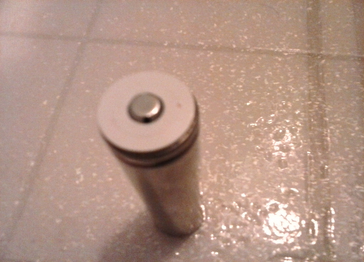
The washer on top seems to be stuck on, which is a good sign...
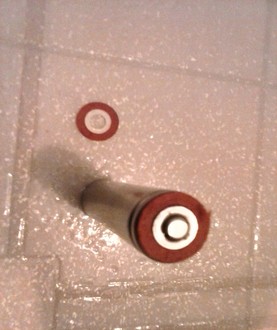
There is indeed a red paper washer underneath the white plastic one...
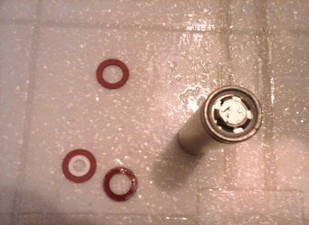
And finally, the button-top pops off to reveal a Sanyo style flat-top positive terminal. Sanyo is indeed the company that UltraFire uses for their batteries. Other than it's claimed capacity rating, this cell is very convincing. It even weighs the right amount. So if they changed the capacity rating to 3000 milli-amp hours, and changed the wrapper design to UltraFire's other (protected) style, they might have gotten away with it.
Except for the discharge test...
For a discharge test load, I used a headlamp that took 1000 milli-amps. Being a “4000” milli-amp hour battery, it should have lasted for four hours. For the test, however, it only lasted an hour and a half. That comes out to 1500 milli-amp hours. Not terrible (like the 600 milli-amp hour ones), but not great either.
I also took a closer look at the negative terminal, and found that the cap that supposedly enclosed a protection circuit was actually held down with solder to the real negative battery terminal. If there were actually a protection circuit in there, it would be shorted out and not function at all. I pried it off and found (as expected) nothing under there.
So, a review on how to tell:
Check the capacity
Check for errors and contradictions in the print/terminals
Check the weight
Check the style of the positive terminal
Check the washers on the positive terminal
Check for rust, burns, scratches, wear, dents, or other damage
And some recommendations:
Look at the reviews
See if the ad makes sense
See if the math in the ad adds up properly
Don't buy:
From Ebay
From sellers that tend to “mke lotts of spellling and gramer-errors” in their ad*
Batteries that are less than $5 each
Only buy:
LG
Panasonic
Efest
Sanyo
Samsung
Ultrafire (uses Sanyo cells)
And if you buy UltraFire batteries, only buy them from:
Thanks for reading and good luck with your 18650 batteries!
*Sellers that make lots of spelling and grammar errors unintentionally show that they do not care about good communication, and probably also don't care about a lot of other things.